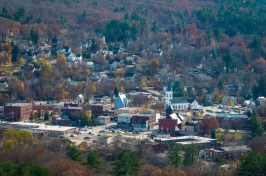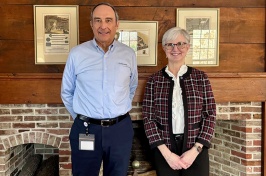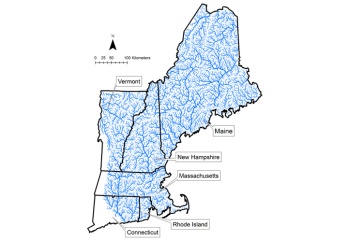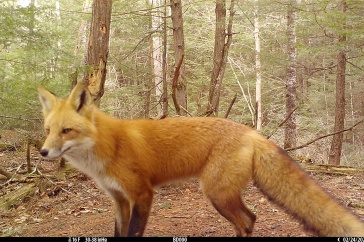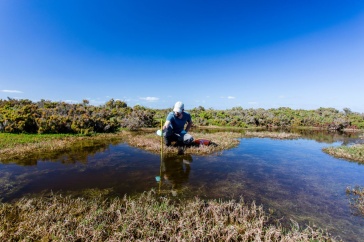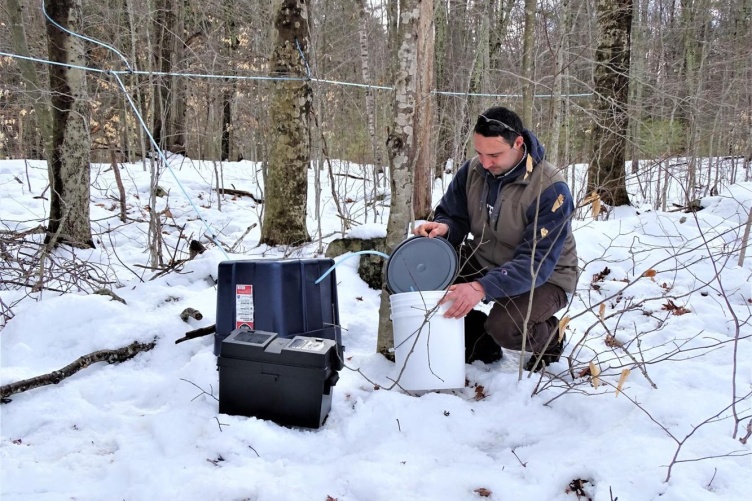
NHAES researcher David Moore collecting sap from beech trees. Image courtesy of Kimberley Haas, New Hampshire Union Leader.
Long before the snow melts and the heavy coats get stored for the season, the quintessential signs that spring is not too far away in New Hampshire are maple trees that become dotted with buckets and the coming alive of the sugar shacks that have been hibernating for many months. In 2022, three New England states—Maine, New Hampshire and Vermont—and New York were in the top six states producing maple syrup. Soon, however, maple syrup may have some friendly competition. New research led by New Hampshire Agricultural Experiment Station scientists examines how tapping non-maple trees—for example, birch and beech, which the Granite State also has in abundance—could increase the economic resiliency of the state’s syrup producers and offer intriguing alternatives to breakfast staples, while providing important ecosystem benefits.
Doctoral candidate David Moore, a member of the UNH Ecohydrology Lab, led the research, which focused on identifying best management practices for harvesting sap and producing syrup from a variety of deciduous trees native to New Hampshire. Moore co-authored a paper — along with a team of current and former UNH researchers — that appeared in the NH Agricultural Experiment Station’s INSPIRED Forestry research report.
Moore, a longtime syrup producer, previously produced birch and sycamore syrup commercially for the Lee-based business The Crooked Chimney.
“When I was an undergraduate at UNH, I did a research project on birch syrup during my senior year to determine which New England birch species was best for syrup production,” said Moore. “Paper birch (Betula papyrifera) sap had, on average, about twice the sugar content as saps from sweet birch (Betula lenta) and yellow birch (Betula alleghaniensis).”



From top left and clockwise: Photos of an American beech, a tulip poplar (not used in syrup production for this research) and an American sycamore trees with sap sensors attached to them.
“Birch syrup has such an intriguing taste that’s so different from maple syrup,” he added, “so I began exploring what other types of trees could be used for syrup production.”
And although many of the non-maple trees that Moore taps—by drilling a small hole into a tree and attaching a sap collection system—contain sap with a much lower sugar concentration than maple, the syrup produced from the sap of those “alternative” trees can fetch four or five times more (about $300 per gallon) as maple syrup does.
Partly in response to market demand, alternative syrup producers are increasing. Twenty years ago, there were no commercial birch syrup producers in New England. Now there are about half a dozen. And alternative syrups mean new opportunities across the Granite State, where beech, white birch and yellow birch rank in the top 10 most abundant tree species (along with red and sugar maple), according to the NH Division of Forests and Lands.
The production of alternative syrups also offers ecological benefits. The syrup industry’s primary reliance on one tree species puts it risk from extreme climate events, pests and pathogens, market changes and other uncertainties. A more diverse sugarbush (a forest of trees tapped for sap) means lower risk if one species is impacted and would offer greater climate resilience.
To complement Moore's research, work done by Shadi Atallah, an associate professor at the University of Illinois Urbana-Champaign’s College of Agricultural, Consumer and Environmental Sciences, and UNH graduate research assistant Jawad Khan showed that providing information to consumers about the type of syrup they are sampling, as well as the potential advantages of promoting sugarbush and forest diversification, resulted in an increase in willingness to pay for a 12.7-oz bottle by as much as $1.10.
“I thought initially that these new syrups would compete with the maple syrup market, but after talking with folks, I don’t necessarily think that happens,” said Moore. “What often occurs is that people who really enjoy pure maple syrup find out that syrup can be produced from different trees and that these different syrups have new flavors, and they get excited to try them.”
“In a sense, these different syrups all complement each other in the market,” he added.
A Taste of Difference

Many are familiar with the taste of syrup that comes from maple tree sap. However, different tree species offer entirely different tastes in the syrup that comes from their sap. For example, the taste of birch syrup can vary depending on the processing method and range from a smoky and burnt flavor to a sweet, light palate with a hint of raspberry, said Moore.
On the other hand, beech tastes akin to your maple syrups, but walnut syrup has a little smoother and nuttier taste than maples, whereas sycamore tastes like honey or butterscotch.
“I’ve had birch syrup that tastes like molasses and birch syrup that tastes almost fruity,” described Moore. “Birch syrup pairs very nicely with savory foods – some folks don’t like the taste of it right away, but when they try it in a dish, they love it.”
“I think sycamore syrup is my favorite out of the bunch – it’s got such a light, sweet, distinct flavor when it’s made right.”
It’s All in the Sugar
Besides water, the most prevalent molecules in sap are sugars. Sucrose—or your common table sugar—is the primary sugar found in sugar maple sap, whereas birch sap largely contains fructose and glucose. Fructose breaks down at lower temperatures than both glucose and sucrose. However, recent technologies like reverse osmosis that don’t rely on heat to concentrate sap can help make the syrup production process more efficient while maintaining the flavor profile, said Moore.
“Boiling sap using heat is desirable for many reasons – it helps develop the nice, caramelized flavor that we love, and it often makes sense for sugarmakers to use wood as a fuel source,” added Moore. “However, reverse osmosis greatly reduces the amount of fuel you use and really makes a difference when burnt off-flavors are a risk.”
This material is based on work supported by the NH Agricultural Experiment Station through joint funding from the USDA National Institute of Food and Agriculture (under Hatch award number 1022415) and the state of New Hampshire, as well as funding from the UNH Collaborative Research Excellence (CoRE) program.
This work was co-authored by David Moore, Station scientist Heidi Asbjornsen, a professor in UNH’s natural resources and environment department; Sherman Bigornia, an assistant professor in UNH’s agriculture, nutrition and food systems department; Matthew Vadeboncoeur, a research scientist with the UNH Earth Systems Research Center; Marta Lima, a research assistant professor at Virginia Tech’s School of Plant and Environmental Sciences; and Shadi Atallah, an associate professor at the University of Illinois Urbana-Champaign’s College of Agricultural, Consumer and Environmental Sciences.
You can read Diversification of the Syrup Industry: Strategies for Climate Resilience and Economic Vitality in the INSPIRED Forestry Research Report from the New Hampshire Agricultural Experiment Station.
-
Written By:
Nicholas Gosling '06 | COLSA/NH Agricultural Experiment Station | nicholas.gosling@unh.edu




























